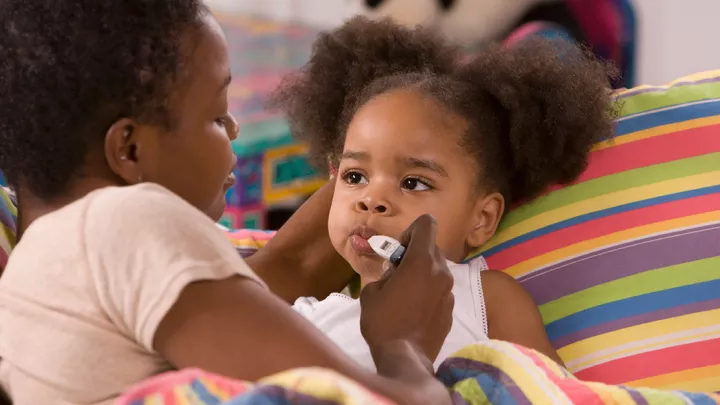
How to Heal Your Baby’s Diaper Rash
If your child is in diapers, at some point you will probably deal with a diaper rash. At least half of all babies develop diaper rash.
But while diaper rash is a common problem, there is plenty you can do to help your baby, according to pediatrician Christopher Tolcher, MD, a member of the Children’s Hospital Los Angeles Care Network. With a few simple steps, Dr. Tolcher explains, you can soothe that skin, speed healing—and help prevent another rash in the future.
What causes diaper rash?
“The two biggest causes are wetness and friction,” Dr. Tolcher says.
Urine and stool caught by the diaper can irritate your baby’s skin over time. Diapers can also chafe or rub against your baby’s bottom, creating friction. Changes in the pH of the skin from pee, poop, or certain skin products can cause a rash.
In addition, Dr. Tolcher points out, soaps can break down skin over time, just as they break down germs and dirt. And, rarely, babies can be allergic to a specific ingredient in a diaper, wipe, or soap.
While diaper rash can occur at any age, it is most common in babies in their first month and at 9 to 12 months old. It is also more likely to happen when your baby:
- Starts eating solid foods
- Begins sleeping through the night (with fewer diaper changes)
- Has a cold or diarrhea
- Is taking antibiotics
Tips for treating diaper rash
A diaper rash can range from mild to severe. With a mild rash, you might see small pink or red spots or patches. In more severe cases, the spots will be a brighter red, or the skin may be cracked, broken, or blistered. The rash may spread down to the legs or up the abdomen, and your baby may be crying or in distress.

“The sooner you start treating the rash, the better,” Dr. Tolcher says. Below, he offers a half-dozen time-tested tips to help that diaper rash disappear. These same tips can also help prevent future rashes, or at least make them less frequent and less severe.
- 1. Ditch the diaper. Giving your baby some “naked time” out of diapers can help speed the healing process. This allows babies to stay dry and avoid friction so their skin can breathe. One remedy Dr. Tolcher advises is to buy disposable waterproof pads (sometimes called “chux”) and let the baby play on a pad without a diaper. Or remove the diaper when your baby is sleeping. The more time with the diaper off, the better, especially in severe cases.
- 2. Change diapers more often. Don’t let your baby sit long in a wet or soiled diaper. Changing diapers frequently is a good way to prevent diaper rash or decrease its severity. Yeast loves to grow in warm, wet areas, so keeping the area dry can prevent the growth of a rash from these infections. The downside to this is more rubbing the skin, so cleaning gently is critical (see below).
- 3. Use a barrier cream—and use a lot of it. A barrier cream protects your baby’s skin from urine and stool. A zinc oxide cream (usually white or cream colored) or a petroleum jelly ointment are good options. You can also use these creams to try to prevent a rash. The key? When the baby has a rash, apply a thick layer of it—like icing on a cake. Many parents apply too little. Another tip from Dr. Tolcher: “You don’t have to remove all the cream with every diaper change, especially if there is no stool present or only a small amount. Leaving some cream on the skin and adding more limits the rubbing on the sensitive skin.”
Christopher Tolcher, MDIf your baby is wearing cloth diapers, it’s a good idea to switch to super-absorbent disposable diapers until the rash is healed
- 4. Be gentle when you clean. You want to reduce the friction on your baby’s bottom, so don’t scrub or rub your baby clean. Gently pat the skin with a soft washcloth in warm water, or dip the baby briefly in a bath. Pat dry with a towel—don’t rub. Warm water is often enough to clean pee and poop. Soaps can be hard on babies’ skin; if warm water is not enough, use a non-soap cleanser (most baby washes fall into this category). If you use baby wipes, choose ones that are free of dyes, scents, and alcohol. Using softer paper towels can also help.
- 5. Switch to disposable diapers. “If your baby is wearing cloth diapers,” Dr. Tolcher says, “it’s a good idea to switch to super-absorbent disposable diapers until the rash is healed.” This will help keep your baby’s skin as dry as possible.
- 6. Check the size. Make sure the diaper fits. A diaper that is too big can rub back and forth on your baby’s bottom. If it’s too small, it traps in moisture and brings the pee and poop too close to the skin.
When to call the doctor
Most mild diaper rashes can be treated at home. The rash should start to improve after just a few days of following the above tips. “It might take several days up to two weeks for it to completely go away,” Dr. Tolcher says.
If your child’s rash is severe or does not improve after several days, or gets worse, call your doctor. A fungal infection might be involved. The doctor might give you a fungal medicine or a mild steroid cream. Dr. Tolcher notes that steroid creams must be used with caution in the diaper area because of potential side effects from overuse.
“Some doctors don’t recommend them at all in this area of the body,” he says.
Dr. Tolcher advises calling the doctor if your child:
- Has a fever (over 100.4 degrees) with the rash
- Has bruises, bleeding, or open sores in the area
- Is in a lot of pain or discomfort
- Is losing weight or seems sick
Diaper rash is a normal part of infancy, but your baby doesn’t have to suffer. Watch for rashes so you can treat them early. And if you have any concerns, call your doctor.


